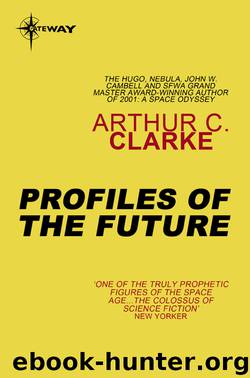Profiles of the Future by Arthur C. Clarke

Author:Arthur C. Clarke [CLARKE, ARTHUR C.]
Language: eng
Format: epub
Publisher: Orion Publishing Group
Published: 2011-09-14T16:00:00+00:00
ELEVEN
ABOUT TIME
Man is the only animal to be troubled by Time, and from that concern comes much of his finest art, a great deal of his religion, and almost all his science. For it was the temporal regularity of nature – the rising of sun and stars, the slower rhythm of the seasons – which led to the concept of law and order and in turn to astronomy, the first of all sciences. Changeless environments like the deep ocean or the cloud-wrapped surface of Venus provide no stimulus to intelligence and in such places it may never be able to arise.
It is not surprising, therefore, that human cultures which exist in regions of negligible climatic variation, like Polynesia and tropical Africa, are primitive and have little conception of Time. Other cultures, forced by their surroundings to be aware of Time, have become obsessed by it. Perhaps the classic example is that of Ancient Egypt, where life was regulated by the annual flooding of the Nile. No other civilisation, before or since, has made such determined efforts to challenge eternity, and even to deny the existence of death.
Time has been a basic element in all religions, where it has been combined with such ideas as reincarnation, foretelling the future, resurrection and the worshipping of the heavenly bodies – as shown by the monolithic calendar of Stonehenge, the Zodiac from the Dendera Temple and the ecclesiastical architecture of the Mayas. Some faiths (Christianity, for instance) have placed Creation and the beginning of Time at very recent dates in the past, and have anticipated the end of the Universe in the near future. Other religions, such as Hinduism, have looked back through enormous vistas of Time and forward to even greater ones. It was with reluctance that Western astronomers realized that the East was right, and that the age of the Universe is to be measured in billions rather than millions of years – if it can be measured at all.
And it is only in the last fifty years that we have learned something about the true nature of Time, and have even been able to influence its progress – though as yet, by no more than millionths of a second. Ours is the first generation, since balance wheels and pendulums started oscillating, to realize that Time is neither absolute nor inexorable, and that the tyranny of the clock may not last for ever.
It is hard not to think of Time as an adversary, and in a sense, all the achievements of human civilization are the trophies that Man has won in his war against Time. Whatever their motives may have been, the cave artists of Lascaux were the first to win any gains for mankind. About a thousand generations ago, when the mammoth and the sabre-toothed tiger still walked the Earth, they discovered a way of sending not merely their bones but some at least of their thoughts and feelings into the future. We can look through their eyes, across the gulfs of time, and see the animals that shared their world.
Download
This site does not store any files on its server. We only index and link to content provided by other sites. Please contact the content providers to delete copyright contents if any and email us, we'll remove relevant links or contents immediately.
Whiskies Galore by Ian Buxton(41937)
Introduction to Aircraft Design (Cambridge Aerospace Series) by John P. Fielding(33092)
Small Unmanned Fixed-wing Aircraft Design by Andrew J. Keane Andras Sobester James P. Scanlan & András Sóbester & James P. Scanlan(32764)
Craft Beer for the Homebrewer by Michael Agnew(18196)
Turbulence by E. J. Noyes(7977)
The Complete Stick Figure Physics Tutorials by Allen Sarah(7338)
Kaplan MCAT General Chemistry Review by Kaplan(6899)
The Thirst by Nesbo Jo(6877)
Bad Blood by John Carreyrou(6581)
Modelling of Convective Heat and Mass Transfer in Rotating Flows by Igor V. Shevchuk(6406)
Learning SQL by Alan Beaulieu(6237)
Weapons of Math Destruction by Cathy O'Neil(6214)
Man-made Catastrophes and Risk Information Concealment by Dmitry Chernov & Didier Sornette(5956)
Digital Minimalism by Cal Newport;(5704)
Life 3.0: Being Human in the Age of Artificial Intelligence by Tegmark Max(5514)
iGen by Jean M. Twenge(5385)
Secrets of Antigravity Propulsion: Tesla, UFOs, and Classified Aerospace Technology by Ph.D. Paul A. Laviolette(5333)
Design of Trajectory Optimization Approach for Space Maneuver Vehicle Skip Entry Problems by Runqi Chai & Al Savvaris & Antonios Tsourdos & Senchun Chai(5037)
Pale Blue Dot by Carl Sagan(4953)
